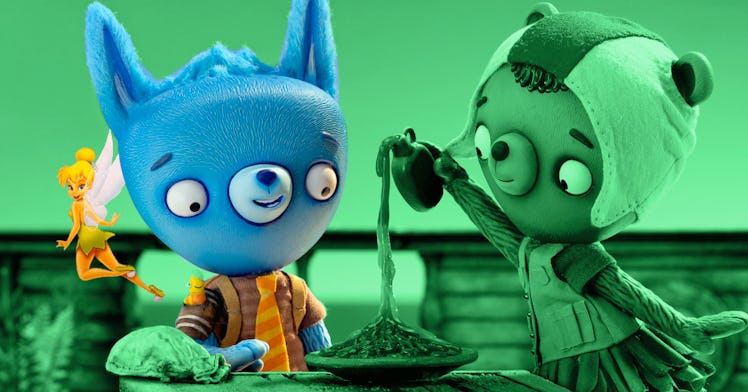That Adorable ‘Tumble Leaf’ Ship Might Hold a Deep, Dark, Secret
Once you see it, you can't unsee it.

By now, I’m sure you’ve seen at least a couple of episodes of the hit kids’ show, Tumble Leaf. This Amazon Prime show follows Fig the fox around the island of Tumble Leaf as he explores new objects from the Finding Place (a treasure chest in his ship/home) and goes on adventures with his animal pals. It’s one of the few kids shows out there I’m really fond of– I love the creativity and whimsy built into Fig’s world. But as I sat down to watch with my three-year-old last weekend, I couldn’t help noticing this feeling of deja vu– something about this magical place felt really familiar. As the fifth or so episode started, it finally hit me: the island of Tumble Leaf might really the island of Neverland, just stop motion-ized.
In a sense, if this were true, it would make Tumbe Leaf a slightly more palatable version of Peter Pan, but paradoxically, make Tumble Leaf also slightly darker than it appears.
The first thing that brought Neverland to mind was the ship Fig lives on. It’s a giant, double-decked ship with a big wooden steering wheel and beautiful red finishes throughout. You can tell it was really something back in its prime, but it’s clearly been shipwrecked on the beach where Fig lives for a while; there are giant holes in its body, its sides are weather-worn, and you can’t miss the enormous tree growing out of its center where a mast used to be. Besides the tree, it looks an awful lot like Captain Hook’s ship, the Jolly Roger.
Now, the Jolly Roger has a long history of switching captains, switching mediums, and switching worlds. The Jolly Roger was first captained on-screen by Hook in 1958’s animated Peter Pan and then stolen by Pan and the Lost Boys. It was returned to Hook in Spielberg’s 1991 live-action movie, Hook. Since then, many Jolly Rogers have appeared in other Pan spinoffs, from Mickey Mouse video games to a cameo in the credits of 2014’s The Pirate Fairy. But I believe these to be descendent Jolly Rogers, built in honor of the original. The last time anyone saw the real Jolly Roger, she was being sunk by an octopus in 2002’s lackluster sequel, Peter Pan: Return to Neverland. My theory is that the octopus who dragged the original Jolly Roger down is none other than Okra, the octopus in Tumble Leaf. And if Okra has the power to drag an entire ship underwater, she certainly can drag it a little further, say, to another coast off Neverland. The Jolly Roger was forgotten there for twelve years, sprouted a tree, and was found in 2014 by…Fig the fox.
But how did Fig and other Tumble Leaf characters get to Neverland, you might ask? The answer is hidden in the original Peter Pan movie. This is the classic Pan everyone knows and, um, used to love (these racist parts have changed our minds!). In the film, the Lost Boys are little boys known for their curiosity, adventure, and– wait for it– animal costumes they wear so they won’t be seen by Captain Hook. Lost Boy “Slightly” wears a fox costume. “Cubby” wears a bear costume. Tumble Leaf’s Fig is a fox. His best friend Maple is a polar bear. The speaking, child-aged characters on Tumble Leaf are none other than the Lost Boys of Neverland.
I can’t match every Tumble Leaf character to a Lost Boy (sadly “Hedge” in Tumble Leaf has no hedgehog counterpart in Pan, and “Tootles”, a skunk from Pan, never makes an appearance in Tumble Leaf), but there’s a good reason. In the 2004 book, Peter and the Starcatchers, it’s explained that some lost boys choose to leave the island so they can grow up, and Peter returns to Neverland from time to time with new batches of lost boys who wish to stay young. And as for why some of the Lost Boys (speaking animal characters) on Tumble Leaf are girls, well– one theory is that the island evolved and finally began accepting girls. Another theory could be taken from 2006’s book Peter Pan in Scarlet, which tells the story of Lost Boy “Tootles” who becomes a girl because he can only find girls’ clothes to dress in.
Tumble Leaf characters as Lost Boys explains why some animals on Tumble Leaf can talk, like Fig, Maple, and Hedge, while others can’t– like his chicken friends, or Stick the caterpillar. The talking animals aren’t animals at all– just little boys (and girls) whose animal costumes have become more and more real throughout the years.
Even the creators of Tumble Leaf have said that Fig was originally created as a blue little boy, but throughout their revisions somehow became a fox. Coincidence? I think n-Ok, probably. But the next time your little sits you down to watch another hour of Tumble Leaf, you’ll thank me. Once you see these two islands as the same, you’ll never stop making the connections.
And, without spoiling anything, when you get to the final episode of Tumble Leaf, you might be reminded of that famous line from Peter Pan, “Second star to the right, and straight on til morning.”
Tumble Leaf, one of the gentler, and better shows for toddlers is streaming on Amazon Prime.